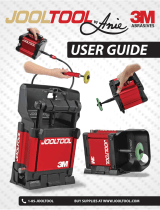2 www.drilldoctor.com www.drilldoctor.com 3
IMPORTANT SAFETY INSTRUCTIONS
For your own safety, please read this User’s Guide before
operating the Drill Doctor
®
.
Installation
• Carefully unpack the Drill Doctor
®
drill bit sharpener
and set it on a table. Check to see that no damage has
occurred in shipment. Check all packing material to be
sure that all parts are present. See User’s Guide for
part identification diagram.
• The unit is completely assembled; the Drill Doctor
®
only needs to be placed on a flat stable tabletop.
• Connect to properly wired outlet.
Precautions
When using electric tools, basic safety precautions should
always be followed to prevent the risk of fire, electric
shock, and personal injury.
• KEEP WORK AREA CLEAN. Cluttered areas and
bench invite accidents.
• DO NOT USE IN DANGEROUS ENVIRONMENT. Do
not use in damp or wet locations, avoid exposure to
rain. Keep work area well lit. Do not use tools in the
presence of flammable liquids or gases.
• GUARD AGAINST ELECTRIC SHOCK. Avoid body
contact with earthed or grounded surfaces (e.g., pipes,
radiators, ranges, refrigerators).
• KEEP OTHER PERSONS AWAY. Do not let persons,
especially children, not involved in the work touch the
tool or the extension cord and keep them away from
the work area.
• STORE IDLE TOOLS. When not in use, tools should be
stored in a dry, locked-up place out of the reach of chil-
dren.
• DO NOT FORCE THE TOOL. It will do the job better
and safer at the rate for which it was intended.
• DRESS PROPERLY. Do not wear loose clothing or jew-
elry; they can be caught in moving parts. Wear protec-
tive hair covering to contain long hair.
• USE PROTECTIVE EQUIPMENT. Use safety glasses.
Use face or dust mask if working operations create
dust.
• DO NOT ABUSE THE CORD. Never yank the cord to
disconnect it from the socket. Keep the cord away from
heat, oil and sharp edges.
• MAINTAIN TOOL WITH CARE. Keep the Drill Doc-
tor
®
clean for best and safest performance. Follow
instructions for maintenance and changing acces-
sories. Inspect cords periodically and if damaged have
them repaired by an authorized service facility. Inspect
extension cords periodically and replace if damaged.
Keep unit dry, clean and free from oil and grease.
• DISCONNECT TOOLS. Always disconnect the Drill
Doctor
®
when cleaning, inspecting, and changing
accessories, such as the diamond sharpening wheel.
When not in use, disconnect from the power supply.
Never touch internal parts of the sharpener when it is
turned on or plugged in. The rotating diamond wheel
can cause injury.
• AVOID UNINTENTIONAL STARTING. Make sure
switch is in the “OFF” position before plugging in.
• STAY ALERT. Watch what you are doing, use common
sense and do not operate the tool when you are tired.
• CHECK DAMAGED PARTS. Before use of the tool, it
should be carefully checked to determine that it will
operate properly and perform its intended function.
Check for alignment of moving parts, binding of mov-
ing parts, breakage of parts, mounting and any other
conditions that may affect its operation. A guard or
other part that is damaged should be properly repaired
or replaced by an authorized service center unless oth-
erwise indicated in the instruction manual. Have defec-
tive switches replaced by an authorized service center.
Do not use the tool if the switch does not turn it on and
off. Do not use if the grinding wheel is damaged. Use
only grinding wheels recommended by Drill Doctor
®
.












